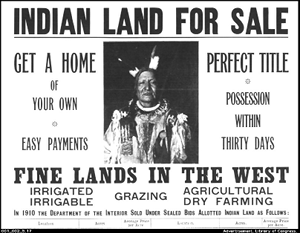The Dawes Act
After the Civil War, the U.S. Government departed from a pattern of removal of Native Americans from their native lands and onto other lands, notably reservations, and focused on a policy of assimilation. An extreme example of this was the Dawes Act, which went into effect on Feb. 8, 1887. 
Named for its author, Massachusetts Sen. Henry Dawes, the Act was also known as the General Allotment Act or the Severalty Act. The idea was to break up reservations on which Native Americans were living into small blocks of land. The head of a family could have 160 acres of land; orphans 18 or older could have 80 acres; those under 18 could receive 40 acres. A Native American could accept the proposal to live on an individual plot of land and then become a U.S. citizen. Any individual plot not claimed by a Native American would be sold to non-Native American settlers. The people behind the law believed that Native Americans who became U.S. citizens would shed vestiges of their tribal customs and fully embrace the culture and customs of America. The allotment system aimed to remove the various secondary elements of autonomy that some Native Americans had been able to hold on to under the reservation system. Members of a few tribes were exempt from this requirement. The so-called Five Civilized Tribes (Cherokee, Chickasaw, Choctaw, Creek, and Seminole) had already taken on a few of the trappings of American civilization. Also exempt were members of the Fox, Miami, Osage, Peoria, Sac, (New York) Seneca, and some members of the Sioux Nation. Four years later, Congress amended the Dawes Act to, among other things, set inheritance criteria. In between the passage of the original act and the crafting of the amendments, the U.S. Government had changed the rules in Indian Territory and allowed white settlers to take over land formerly allotted for Native Americans; one prominent result was the Oklahoma Land Rush. Congress created an even more pervasive set of amendments in 1898. The Curtis Act reversed an earlier exception and extended the Dawes Act restrictions and allotment system to the Five Civilized Tribes, also wiping out their tribal courts. Congress continued with the allotment schemes into the 20th Century, eventually ending them with the Indian Reorganization Act of 1934. Including its various extensions, the Dawes Act provisions decreased land owned by Native Americans from 138 million acres in 1887, the year that the original Dawes Act was passed, to 48 million acres in 1934. |
|
Social Studies for Kids
copyright 2002–2026
David White




